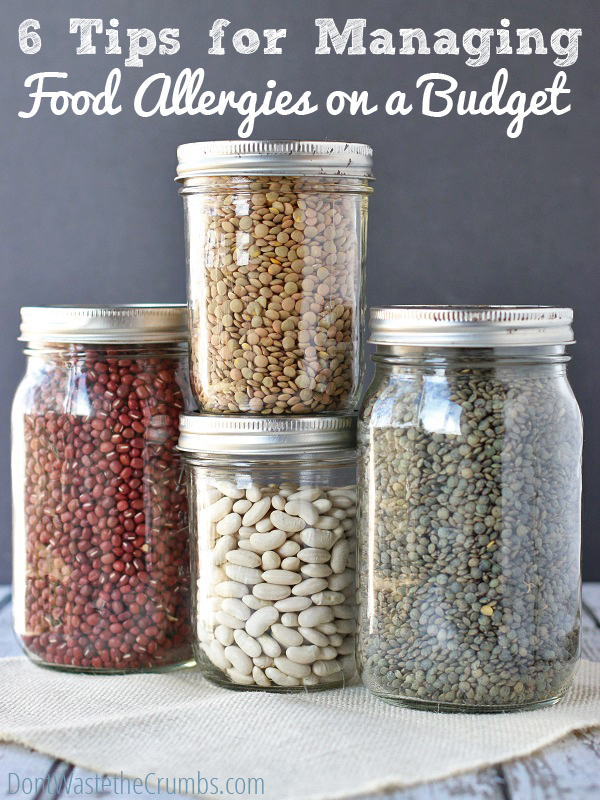One of my dear friends is deep in the throes of learning how to manage a family with food allergies. Her son has struggled with eczema since birth, but it wasn’t until a few months ago that he was officially diagnosed with an allergy to dairy.
Like many families in similar situations, my friend was already struggling with affording healthy foods. Throwing a food allergy into the mix meant more work, more time, and more money.
My family has been fortunate to not have food allergies, so watching her go through this, as well as other dear friends like Kelly, has really opened my eyes to the struggles that many families go through.
Since I know many of you here may be dealing with food allergies and intolerances too, I’ve been collecting helpful tips and ideas from my friend, so that I can share them with you all. I hope these six simple, yet practical tips for managing food allergies and intolerances on a budget will help you to save money, and stay on track with feeding your family nourishing real foods.
6 Tips for Managing Food Allergies & Intolerances on a Budget
1. Focus on what you CAN eat.
When we find out there’s something we can’t have, it’s in our nature to suddenly focus ONLY on the restricted food(s). Doing this will leave you feeling defeated. Instead, focus on the many delicious and nutritious foods that you can eat. Take some time to learn how to use seasonings and tasty ingredient combinations to keep your meals satisfying and your diet varied. By doing so, you’ll find that you actually miss those restricted foods a lot less!
2. Keep it simple.
Skip fancy ingredients and complicated recipes for awhile, and instead, focus on keeping meals simple. This will not only allow you to more easily adjust to your new diet without becoming overwhelmed, but will also enable you to learn to manage your new dietary lifestyle within your budget. That’s because simple meals cost less and are also less stressful to put together.
A simple meal formula is protein + carb + produce. For example, chicken + sweet potato + mixed greens salad. So if you need to eat simple meals like this for a few weeks so you get a handle on your budget and new diet, then do it! It’s a short term solution that will give you time to adjust. Remember, meals are meant to nourish, not to cause stress.
3. Cook from scratch, when it counts.
Feeding a family while trying to manage food allergies generally means spending more time in the kitchen. And while it’s usually healthier to cook from scratch, your time is precious and there’s only so much of it to go around.
So carefully consider what you want to spend your time cooking from scratch and really make it count! For example, there’s no point in making homemade non-dairy yogurt if your family doesn’t eat much yogurt. Alternatively, you might want to consider taking the time to make grain-free bread if you regularly enjoy having toast for breakfast or a sandwich for lunch.
4. Be picky about allergy-free substitutions.
There are tons of substitutions available for all sorts of allergies, but it’s important to discern between what substitutions are healthy and worth your money, and which are not. For example, many commercial egg replacers are expensive and are nothing more than empty calories. A better option would be to research homemade egg substitutions and find some that are tried-and-true for your needs. Flaxseed and chia seeds are both great substitutions, and are affordable when you buy them in bulk.
Tip: Download a free guide to affordable gluten-free foods at Costco HERE.
5. Buy specialty items in bulk.
Once you’ve figured out how to balance simple meals with cooking new favorite allergy-free fare, take the time to find a quality source for your allergy-free ingredients and know what’s a good price to pay. Then, when prices are at their absolute lowest, stock up. Whether it’s gluten-free and grain-free flours, or non-dairy milk, stocking up on allergy-friendly ingredients that you use frequently – when prices are rock bottom – will help you to save money.
Remember, “buying in bulk” doesn’t mean having to buy from bulk bins in grocery stores, where cross-contamination may be an issue. Instead, many companies offer bulk-size packages of their allergy-free products, which will help you save money without risking accidental exposure to allergens. In addition, many health food stores and markets offer discounts for buying foods by the case. So taking advantage of these types of discounts can really add up to big savings over time.
P.S. Keeping a price book is a great way to track prices and sources. If you’ve never created one before, here’s a simple method for creating a price book.
6. Get a better handle on budgeting.
If your new dietary lifestyle is making it a challenge to stay within budget, take some time to learn more methods for saving money. Strategies like creating a weekly meal plan, buying in bulk (as mentioned above), shopping farmers markets for locally grown produce, and limiting organic produce to just the dirty dozen, are just a few ways you can work to further stay within budget.
Feeding a family with food allergies and food intolerances doesn’t have to break your budget. With a bit of creativity, a few practical tips and a little extra effort, eating healthy, allergy-free foods on a budget is within your reach!
How do you keep your grocery bill down while addressing food allergies and food intolerances?






I’m afraid this article is exactly what I thought it would be when I saw the title…an article about people with food “intolerances”, not food allergies- which are life threatening for the most part.
Make a batch of cookie and use dairy chips in half and non-dairy in the other half? That is incredibly dangerous!!! What if the allergic child picks up the cookie with the dairy chips and goes into anaphylactic shock??? And dies??? Was it worth it to save 25 cents on the chocolate chips?
Unfortunately, articles like this make it much harder for those of us in the food allergy community to express the serious nature of true food allergies to family and friends. We have a daughter with a life-threatening tree nut and peanut allergy…we don’t even keep nut products in our home, as that would be like setting a loaded gun on the kitchen counter.
Something that might help this article is to express the difference between food intolerances, or perhaps Oral Allergy Syndrome, Celiac, etc and life-threatening food allergies that will send someone into anaphylactic shock (any true food allergy can kill someone even if they haven’t reacted severely in the past). Check out http://www.foodallergy,org.
And, please edit this article so you aren’t making that incredibly dangerous suggestion about the chocolate chips!!! I pray no relatives of someone with a true food allergies follows that advice!
Thanks.
Hi, Stephanie. Thank you for expressing your valid concerns about the final tip in this article. You raise a very important issue about safety that should be made clear – particularly in the case of avoiding cross-contamination or accidental ingestion. On behalf of Tiffany, I believe her example was not intended to imply that families should not take precautions to ensure safety. In families where anaphylactic shock or Celiac Disease is an issue, there are very important precautions that must be taken to ensure the individual(s) in the home with food allergies – or intolerances – do not come into contact with any unsafe foods based on their allergy or intolerance. So this point would not apply to those families. With that said, I do agree that this is too serious of an issue to assume that people will understand this tip doesn’t apply to everyone. Therefore, I’ve opted to omit this tip entirely, since I believe this is the wisest, safest option. Thank you again for taking the time to express your concerns and be a thoughtful advocate for the allergy community. Many blessings, Kelly
Kelly,
You are wonderful. You responded so graciously. When I re-read my account I realized I was really fired up and not very gracious at all. I so love your website, and have a lot of backed up emotion over life-threatening food allergies (in case you couldn’t tell…lol). So I hope you’ll accept my apology for being less than gracious and a bit condescending. You (and Tiffany) certainly didn’t deserve it, and I appreciate your safety-conscious, kind response.
Blessings,
Stephanie
Oh, Stephanie, you are too sweet! Thank you for this thoughtful note. I appreciate your humble, kind heart. Don’t even give it a second thought. I understand your passion in wanting to make sure that food is handled and consumed safely – especially for those with life-threatening allergies. I do appreciate you bringing this to my attention so that we can ensure no one gets confused and makes a mistake that might lead to accidentally ingesting an unsafe food. Thanks again! Many blessings to you, Kelly 🙂
Yes! You are spot on with all these tips. I just bought 25 pounds of GF nut-free rolled oats because they are less than half the cost of smaller bags of the same oats (usually $6-7 a pound!). My family has strict instructions that no one except the 3 year old is to eat these oats. I usually default to dinners everyone can eat and let the kids without allergies have more variety at breakfast and lunch when they get their own. Otherwise it’s just to much work to be preparing two versions of everything.
I unfortunately don’t feel safe buying in bulk. With a peanut allergy (one that I don’t know how severe it is, as he’s never actually ingested any) I can’t trust bulk bins at the store. Labeling is a must – I appreciate that Azure clearly notes which products they repackage in their own facility alongside nuts, and which come from the manufacturer directly. Like if I wanted to buy oats or rice in bulk, I’d need the 25 lb and not the 10 lb that they repackage.
Hi, Helen. Good point! Thanks for bringing this up! I just want to clarify that buying in bulk doesn’t only refer to purchasing from bulk bins where cross contamination can definitely be an issue. Instead, you can purchase bulk sized packages of allergy-free products rather than buying smaller packages – and this practice will often help you to save money.
As you mentioned, some companies like Azure will ensure their bulk items are allergen free. In my case, since I am gluten intolerant, I purchase the 25 lb bag of blanched almond flour from Honeyville when it’s on sale – that way I am paying far less per pound for this bulk purchase. And because it’s guaranteed to be gluten-free, I know I do not have the cross contamination issue that might happen from purchasing from a bulk bin in a grocery store. 🙂
My family deals with life-threatening allergies on a budget. I think that this post is relevant and helpful to families just getting started feeding a person with allergies frugally. I’d like to add in the idea of recognizing that having an allergy does mean that you will be eating differently than other people and other families. So, your food bill will look different and your meals will look different. In my experience, it was incredibly expensive to try to duplicate our old diet with allergy-safe ingredients. Once I recognized that we just needed to eat differently, I began saving a lot of money! For example, in regards to substitutions, using potato chips to top a casserole is far cheaper than using non-dairy cheese. The casserole looks and tastes completely different, but it’s far cheaper to eat.
Another major cost-saver for my household is to recognize that I can’t feed crowds of people like I used to. I can only afford to feed my family, and I can’t volunteer to contribute dishes to church dinners, potluck meals, or dessert feasts at the office. The safe ingredients that I can have in my household are way too expensive to feed other people.
As an allergy household, I’d like to remind newly diagnosed people that it will take time to find the brands and foods that work for your budget and household. Don’t compare yourself to others as you begin to bring down your spending or you might feel terrible! There was a time before allergies that I spent what Tiffany spends on groceries. With allergies, though, and very, very careful spending/meal planning/bulk ordering/etc I still can’t get my spending anywhere near hers. And that’s okay, because my daughter is safe and can breathe.
Renee, thanks for taking the time to leave this helpful note. I couldn’t agree more with your advice about not comparing yourself with others – that is SO true on so many levels! I appreciate you sharing your experience with us, and I especially relate to your comments about rethinking what we eat and that our meals will look different than how our family and friends eat. I think this note will also be very comforting to people who are struggling with the reality that it does cost more to feed a family with food allergies and intolerances than it does when you don’t have these issues to deal with. I’m glad you mentioned that sometimes it means it’s necessary to cut back on other expenses in order to be able to feed your family safely. It’s definitely a learning curve, but also one that is not impossible. And as you said, the benefits far outweigh the extra time and costs when it comes to our health and our families’. Thanks again for sharing! Blessings, Kelly 🙂
We have been dealing with food allergies for several years, and this is great advice! I find steering clear of allergy-friendly substitutes really saves money. Those types of foods also tend to be more processed and less healthy, and focusing on healing and really healthy foods is so important with food allergies!
So true, Shannon. I steer clear of the gluten-free packaged foods for the same reason – so expensive and the ingredients are empty calories – mostly starches. Thanks for popping over to leave a kind note! 🙂
I am allergic to all dairy products, so it makes cooking for me very difficult. I’m really glad that I was able to find these tips. My husband and I just got married, so we don’t have a super large budget. It looks like I’m going to be cooking from scratch as often as I can from now on.
Hi, Emily. So glad you found this post helpful. We’re so glad you’re here and hope you find the posts and recipes here helpful and encouraging. Blessings, Kelly 🙂